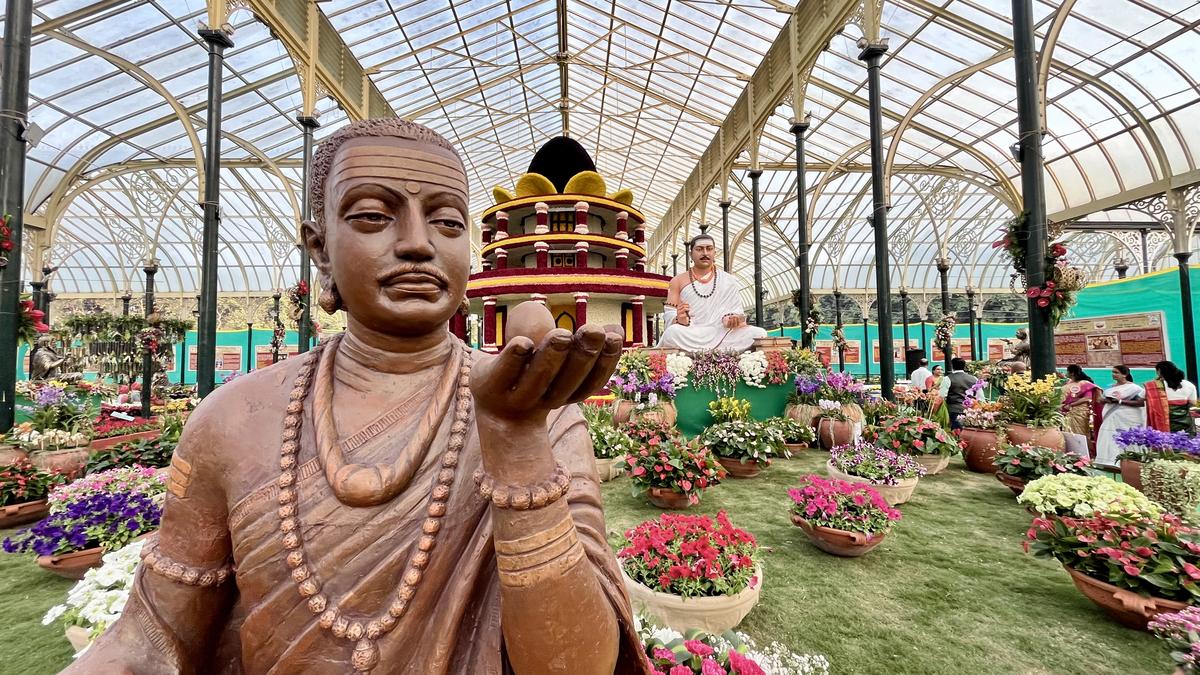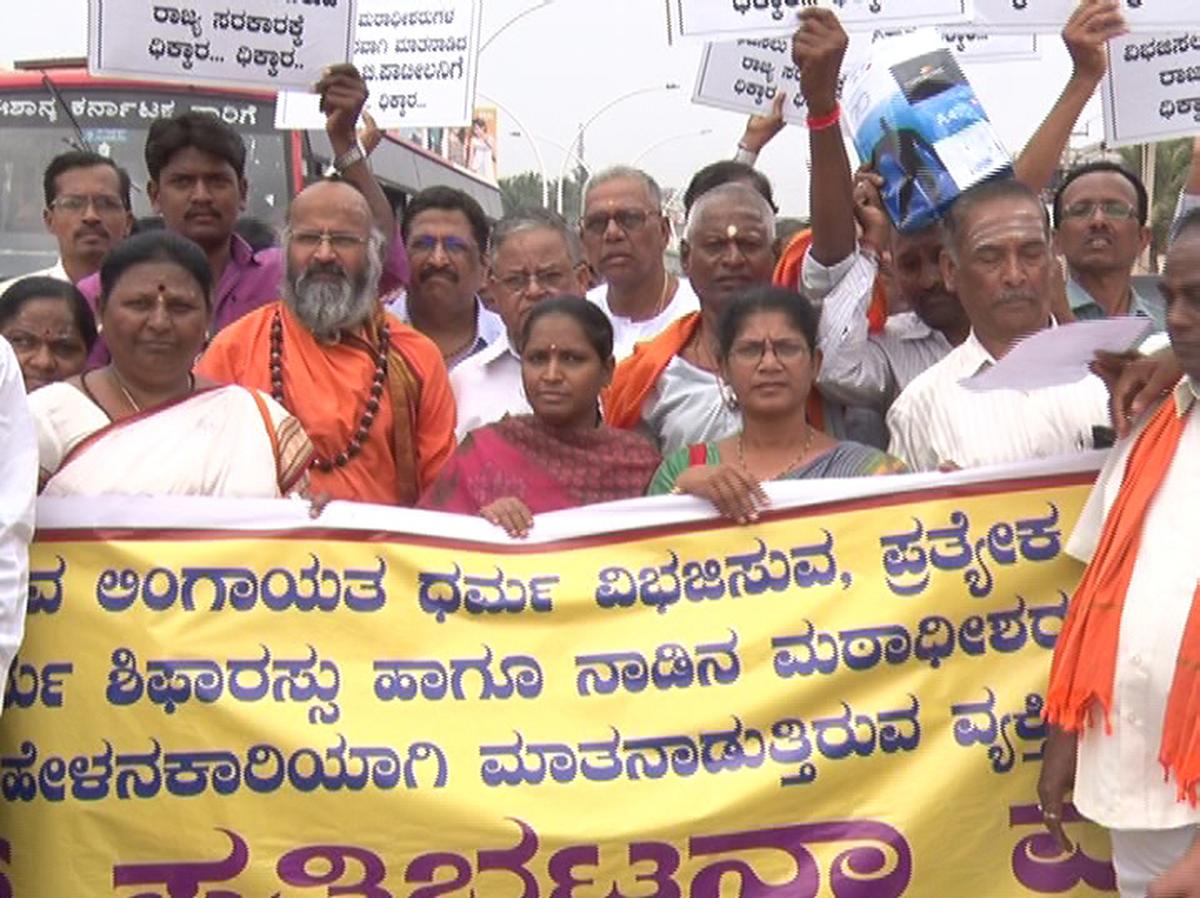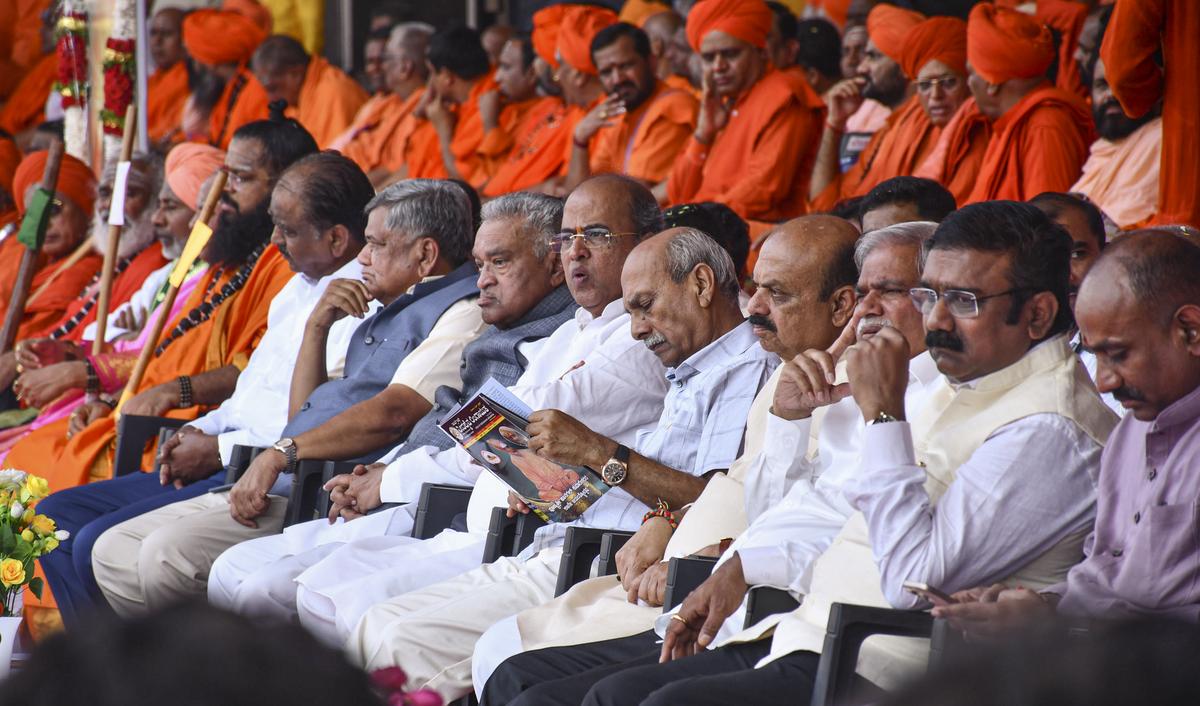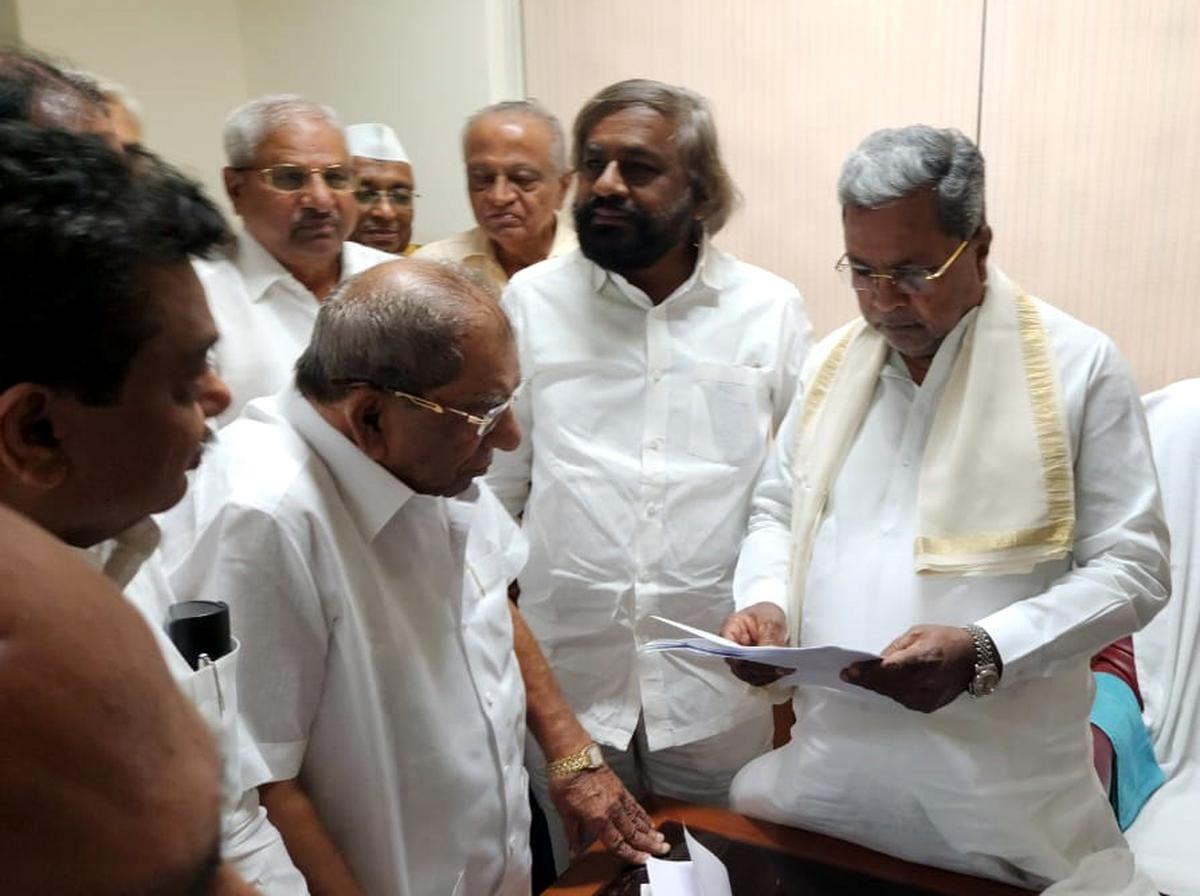The story so far: Even as Karnataka began its second socio-economic survey on September 22, a battle of identities between the Veerashaiva-Lingayat community, the largest caste group in the State, continues to be waged along the sidelines.
The Karnataka Social and Educational Survey 2025 is being conducted by the Karnataka State Commission for Backward Classes to collect data on socio-educational and economic parameters. Though determining “backwardness” of various caste groups is the key objective of the survey, the focus of the dominant communities has been primarily on numerical consolidation.
One aspect that has made headlines consistently is the confusion and disagreements within the Veerashaiva-Lingayat community over nomenclature. There have been clashes over contradictory appeals by representatives of caste organisations, political leaders and seers on how to name their community and caste in the ‘Religion’ column.
Why has the demand for a separate religion for Veerashaiva-Lingayats come up now? What is the confusion around nomenclature?

Who are Lingayats and Veershaivas?
The Lingayats, a numerically and politically strong community of Karnataka, are followers of the 12th century social reformer-philosopher-poet Basaveshwara who defied the caste system and Vedic rituals. They argue that the premise of this rebellion was rooted in opposition to the established Hindu order, and hence want to be categorised as a separate religious group. Lingayats worship ‘Parashiva’ and say that the concept of ‘Ishta Linga’ (personal god) and rules of conduct prescribed by Basaveshwara cannot be equated to the Hindu way of life.

A sculpture of Basavannna during the flower show at Lalbagh in Bengaluru on January 16, 2025.
| Photo Credit:
SUDHAKARA JAIN
The Veerashaiva, on the other hand, is a Shaivate religious tradition. Its followers adhere to the Vedas and claim to predate the reformist movement that created the Lingayats.
The fight for ‘Lingayatism’
Though the demand for a separate identity has come up twice so far, the agitation is over four decades old. The last time it reared its head was in 2017, when a mega movement for an independent religion status for ‘Lingayatism’ saw a resurgence in the run-up to the 2018 Assembly elections.
In December 2017, the Karnataka government led by Chief Minister Siddaramaiah set up a seven-member expert committee headed by the former High Court judge H.N. Nagmohan Das to evaluate proposals seeking to consider Lingayats as a religious minority.
In March 2018, based on the State Cabinet’s approval of the committee’s recommendation, the Karnataka government granted “religious minority” recognition to Lingayats and Veerashaivas who follow Basava Tatva. It also urged the Centre to notify the status under the Central Minority Commission Act.
However, on December 10, 2018, the Union government told the Karnataka High Court that it had rejected the recommendation of the State government to grant religious minority status to Lingayat and Veerashaiva community.
It reiterated what it had said in a November 23, 2018 letter to the State government, that the Lingayat/Veerashaiva community is part of Hindu religion.
It has been reported that Veerashaiva Lingayats will be demanding a religion code for their community in the 16th national census scheduled to begin in October 2026. The ABVLM will press for a code number or a column or abbreviation for recording their religion as Veerashaiva Lingayat in the census form and demand recognition as independent religion.
Who wants what?
The current wave of the ‘separate religion’ movement has gained such significant momentum that for the first time in the recent years, seers of ‘Guru’ and ‘Virakta’ tradition of the Veerashaiva-Lingayat community shared a stage at the Veerashaiva Lingayat Ekata Samavesh’ to send a message that ‘Veerashaiva’ and ‘Lingayat’ were one and the same. However, the convention failed to take a clear stand on choice of nomenclature.
Though the Jagatika Lingayat Mahasabha (JLM), which represents the Lingayats, and the the Akhila Bharatha Veerashaiva-Lingayat Mahasabha (ABVLM), which represents the Veerashaiva-Lingayats, are both working for a separate religion status for the community, differences of opinion continue to persist.
While the JLM has urged the followers of Basaveshwara to register themselves as ‘Lingayat’ under ‘Others’ in the religion column, ABVLM has appealed to community members to mention themselves as belonging to the ‘Veerashaiva-Lingayat’ religion. They both have further been instructed to mention their sub-castes in the caste column.
This is in stark contrast to the demographically-strong and dominant Panchamasali community, which has decided to mention ‘Hindu’ in the religion column and ‘Lingayat Panchamasali’ in the caste column “for the time being”. However, the Akhila Bharatha Lingayat Panchamsali Trust, has asked its followers to enumerate themselves as ‘Lingayat’ under religion.
Some political leaders from the community opposed to the re-categorisation, say the rebellion that formed the Lingayat sect was reformist, like the Bhakti movement, and not aimed at breaking away from the Hindu fold.
BJP leaders, like Vijayapura MLA and expelled BJP leader Basanagouda Patil Yatnal, have cited a loss of reservation benefits to steer Veerashaiva Lingayats away from idenitfying themselves under a new religion. There is no point in registering the religion as Veerashaiva Lingayat unless it is recognised by the Centre, he had said.
A Congress ‘ploy’?
BJP leaders in Karnataka, including former Chief Ministers Basavaraj Bommai and Jagadish Shettar, have labelled the survey as “Congress’s ploy” to divide the larger Hindu community using caste organisations. They said that while the Constitution recognises only six religions, an ‘Others’ column has also been provided in the survey to instigate Veerashaiva-Lingayats and break the unity of Hindus.
Considering the electoral consequences of heeding the demand in 2018, the Congress is being extra cautious this time around, dispelling any uncertainties around the survey. “Let there be no suspicion about this. This is not a caste survey. It’s about social justice. We want to uplift communities socially and educationally. There is no need to suspect otherwise. We have given people the choice to self-declare,” Deputy CM D.K. Shivakumar stated.

Members of Veerashaiva Lingayat, Panchamsali community and seers of different mutts staging dharana in Davangere.
| Photo Credit:
EMAIL HANDOUT
Incidentally, Congress leaders who have batted for a separate religion code for the community include Cabinet Ministers Eshwar Khandre and M.B. Patil, MLA Shamanur Shivashankarappa (who is also the president of ABVLM), Vijayanand Kashappanavar, Vinay Kulkarni, among others.
Additionally, the inclusion of Christian sub-castes such as Lingayat Christian, Kuruba Christian, Brahmana Christian, and Vokkaliga Christian also created a controversy, with Veerashaiva-Lingayat seers accusing the Siddaramaiah-led Congress government of deliberately attempting to encourage conversions. Following the uproar, the Commission later decided to mask 33 Christian sub-castes from the survey.
What are the political ramifications?

Former Karnataka chief ministers Basavaraj Bommai and Jagadish Shettar with other political leaders and seers of both ‘Guru’ and ‘Virakta’ traditions of the Veerashaiva Lingayat community at the ‘Veerashaiva Lingayat Ekata Samavesha’, in Hubballi on September 19, 2025.
| Photo Credit:
PTI
Lingayats, said to comprise 10-17% of Karnataka’s population and listed in the 3B category under Other Backward Classes, hold immense political clout especially in the Kalyana Karnataka and Kittur Karnataka regions.
While the Congress had 26 Veershaiva-Lingayats in its ranks in 2013, its support to a separate Lingayat movement proved costly bringing the number of community leaders elected on the party ticket to 16 in 2018. It is speculated that this was also the reason for CM Siddaramaiah’s loss in the Chamundeshwari seat in Mysuru district which has a significant number of Lingayat population.

However, the tide turned in 2023, when as many as 34 Veerashaiva-Lingayats won on a Congress ticket — the best since 1989, when the party had 45 Veerashaiva-Lingayat legislators.
The saffron party, on the other hand, which had 38 Veerashaiava-Lingayat legislators in 2018, is now down to 18. Numerically outnumbered by the Congress now, the BJP and RSS are anxious that the demand for a religious minority tag could further splinter the Hindu votes and are upset at the sabhas that have appealed to the communities to not categorise themselves as ‘Hindu’.
It is to be noted that pressure from the Veerashaiva-Lingayat community played a major role in the State government taking up a fresh socio-educational survey. Caste leaders had claimed that while their community constitutes about 17% to 22% of the State’s population (some even said it was 30%), the number was downplayed in the 2015 survey conducted by the H. Kantharaj Commission, which pegged their population at about 66.35 lakh, or about 11%. The community, for decades, has bargained for political clout using their estimated population data.

Lingayat leaders giving a memorandum to Chief Minister Siddaramaiah in Belagavi to shelve the caste survey report in 2023.
| Photo Credit:
BADIGER PK
Will there be an impact?
Meanwhile, Backward Classes Commission chairman Madhusudan Naik has said that there is no value for religion column in the enumeration since religion does not come under the purview of the commission. “We will not be evaluating on the basis of religion and information is being sought under a broader category.”
Responding to the attempts made by Veerashiava-Lingayat groups to enumerate their community members under “others” in the religion category, he had said, “In their movement for religion, they can advise their community members to write in a certain manner to assert themselves. But when we analyse, it will have no value. Our concern is to have an analysis based on socio, economic, educational and political backwardness.”
